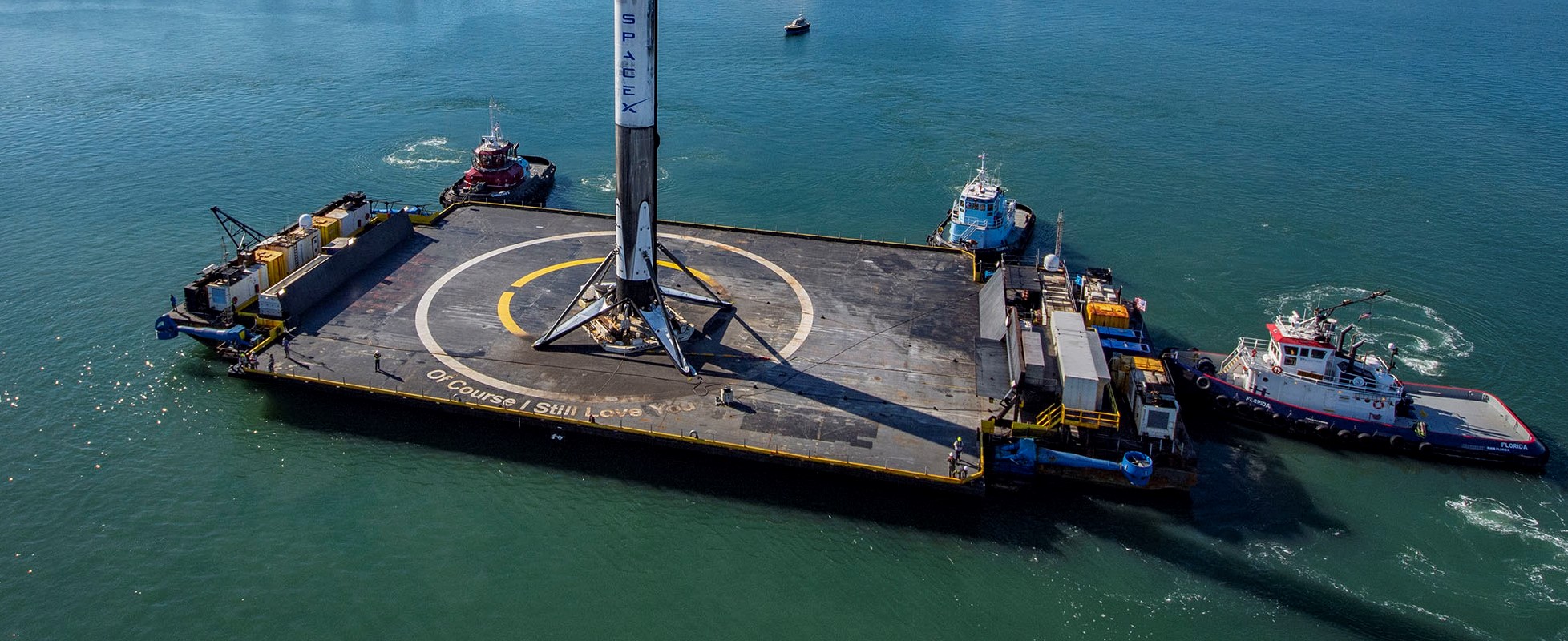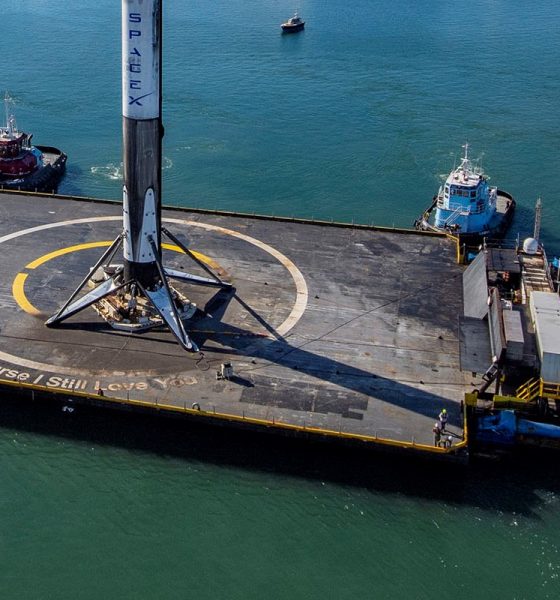

News
SpaceX adds a second drone ship to its East Coast rocket recovery fleet
On December 10th, SpaceX’s East Coast rocket recovery fleet added a second drone ship to its ranks in a bid to expand its capabilities to support dozens of annual Falcon 9 and Heavy launches, as well as experimental Starship and Super Heavy booster recoveries.
Formerly stationed out of Port of Los Angeles to support SpaceX’s once-substantial West Coast launch manifest, the need for West Coast launches has rapidly dried up over the last six months. That drought had such a long lead that SpaceX decided to transfer drone ship Just Read The Instructions (JRTI) through the Panama Canal, moving the vessel several thousand miles from Port of Los Angeles to Port Canaveral, Florida.
JRTI made it through the Canal several months ago and headed East towards Florida before making an intriguing and lengthy pit stop in a Louisiana port. While there, marine engineers and technicians performed a number of unknown tasks presumed to be a scheduled period of inspections and maintenance. In the last few weeks JRTI spent in Louisiana, SpaceX loaded the drone ship with more than a dozen huge generators and power controllers, as well as six massive maneuvering thrusters.
Although perspectives were lacking while JRTI was docked in LA, it was clear that some (or all) of the new hardware was meant for the drone ship, indicating that the rocket recovery platform could be in for some major upgrades. The aforementioned thrusters are much larger and appear to be heavier than JRTI’s former blue azimuth thrusters, four of which also adorn Florida-based drone ship Of Course I Still Love You (OCISLY).
Those massive thrusters are presumably meant for JRTI (and possibly OCISLY). The fact that they have been delivered alongside an even larger number of generators – far more than are usually present on SpaceX drone ships – indicates that their power output is probably larger, too. It’s not clear how much more powerful they are but one goal is unequivocal: with more powerful thrusters, SpaceX’s drone ships should be much more tolerant of bad weather, meaning that SpaceX will be able to launch Falcon 9, Falcon Heavy, and Starship without having to worry as much about the weather hundreds of miles downrange.
Depending on how powerful they are, it’s also possible that those upgraded thrusters are strong enough to independently power drone ships to and from their ocean landing zones. As of now, SpaceX must contract days of tugboat services to tow drone ships to and from their landing zones, by far one of the biggest recurring costs for booster recoveries. If a major power supply upgrade and much larger thrusters are indeed enough to enable independent cruise capabilities, it could significantly streamline SpaceX’s drone ship recovery efforts, cutting costs and increasing flexibility and availability.
It’s hard to say why drone ship JRTI only brought six new thrusters with it, given that SpaceX’s East Coast fleet now has two drone ships and four thrusters are needed to enable stationkeeping on just one of them. Perhaps two more thrusters are on backorder and will be delivered directly to Port Canaveral. More likely, only one drone ship – likely JRTI – will initially be upgraded with new thrusters and power equipment, leaving two spare thrusters in case those installed are damaged by recovery attempts or fail for more mundane reasons.
In the past, drone ship OCISLY has suffered a handful of recovery anomalies that forced SpaceX to replace the vessel’s blue azimuth thrusters and their associated hydraulic equipment. In some cases, a lack of replacement thrusters lead SpaceX to scavenge drone ship JRTI, leaving the ship without thrusters for several months. With these latest upgrades, SpaceX has presumably learned from those past mistakes and ensured that several spare generators and thrusters are on hand.
Given that SpaceX has yet to install those upgraded thrusters or generators on either JRTI or OCISLY, as well as the general uncertainty surrounding their purpose, it’s safe to say that the next several weeks will be exciting. For now, it’s unknown when JRTI will be ready to support its first East Coast rocket recovery, but there will be plenty of launches to choose from once she is.
With two drone ships now stationed out of Port Canaveral, SpaceX will be able to support a more capable Falcon Heavy configuration, expending the center core while recovering both side boosters at sea. SpaceX will also be able to attempt experimental Starship and Super Heavy drone ship landings while still having a spare ship to support its regular Falcon 9 missions. Most importantly, two drone ships will allow SpaceX to reach launch/landing cadences and turnaround times previously impossible with a single ship, an absolute necessity if the company hopes to achieve its goal of ~24 Starlink launches on top of 10+ commercial launches in 2020.
Check out Teslarati’s Marketplace! We offer Tesla accessories, including for the Tesla Cybertruck and Tesla Model 3.

News
Tesla FSD fleet is nearing 7 billion total miles, including 2.5 billion city miles
As can be seen on Tesla’s official FSD webpage, vehicles equipped with the system have now navigated over 6.99 billion miles.

Tesla’s Full Self-Driving (Supervised) fleet is closing in on almost 7 billion total miles driven, as per data posted by the company on its official FSD webpage.
These figures hint at the massive scale of data fueling Tesla’s rapid FSD improvements, which have been quite notable as of late.
FSD mileage milestones
As can be seen on Tesla’s official FSD webpage, vehicles equipped with the system have now navigated over 6.99 billion miles. Tesla owner and avid FSD tester Whole Mars Catalog also shared a screenshot indicating that from the nearly 7 billion miles traveled by the FSD fleet, more than 2.5 billion miles were driven inside cities.
City miles are particularly valuable for complex urban scenarios like unprotected turns, pedestrian interactions, and traffic lights. This is also the difference-maker for FSD, as only complex solutions, such as Waymo’s self-driving taxis, operate similarly on inner-city streets. And even then, incidents such as the San Francisco blackouts have proven challenging for sensor-rich vehicles like Waymos.
Tesla’s data edge
Tesla has a number of advantages in the autonomous vehicle sector, one of which is the size of its fleet and the number of vehicles training FSD on real-world roads. Tesla’s nearly 7 billion FSD miles then allow the company to roll out updates that make its vehicles behave like they are being driven by experienced drivers, even if they are operating on their own.
So notable are Tesla’s improvements to FSD that NVIDIA Director of Robotics Jim Fan, after experiencing FSD v14, noted that the system is the first AI that passes what he described as a “Physical Turing Test.”
“Despite knowing exactly how robot learning works, I still find it magical watching the steering wheel turn by itself. First it feels surreal, next it becomes routine. Then, like the smartphone, taking it away actively hurts. This is how humanity gets rewired and glued to god-like technologies,” Fan wrote in a post on X.
News
Tesla starts showing how FSD will change lives in Europe
Local officials tested the system on narrow country roads and were impressed by FSD’s smooth, human-like driving, with some calling the service a game-changer for everyday life in areas that are far from urban centers.

Tesla has launched Europe’s first public shuttle service using Full Self-Driving (Supervised) in the rural Eifelkreis Bitburg-Prüm region of Germany, demonstrating how the technology can restore independence and mobility for people who struggle with limited transport options.
Local officials tested the system on narrow country roads and were impressed by FSD’s smooth, human-like driving, with some calling the service a game-changer for everyday life in areas that are far from urban centers.
Officials see real impact on rural residents
Arzfeld Mayor Johannes Kuhl and District Administrator Andreas Kruppert personally tested the Tesla shuttle service. This allowed them to see just how well FSD navigated winding lanes and rural roads confidently. Kruppert said, “Autonomous driving sounds like science fiction to many, but we simply see here that it works totally well in rural regions too.” Kuhl, for his part, also noted that FSD “feels like a very experienced driver.”
The pilot complements the area’s “Citizen Bus” program, which provides on-demand rides for elderly residents who can no longer drive themselves. Tesla Europe shared a video of a demonstration of the service, highlighting how FSD gives people their freedom back, even in places where public transport is not as prevalent.
What the Ministry for Economic Affairs and Transport says
Rhineland-Palatinate’s Minister Daniela Schmitt supported the project, praising the collaboration that made this “first of its kind in Europe” possible. As per the ministry, the rural rollout for the service shows FSD’s potential beyond major cities, and it delivers tangible benefits like grocery runs, doctor visits, and social connections for isolated residents.
“Reliable and flexible mobility is especially vital in rural areas. With the launch of a shuttle service using self-driving vehicles (FSD supervised) by Tesla in the Eifelkreis Bitburg-Prüm, an innovative pilot project is now getting underway that complements local community bus services. It is the first project of its kind in Europe.
“The result is a real gain for rural mobility: greater accessibility, more flexibility and tangible benefits for everyday life. A strong signal for innovation, cooperation and future-oriented mobility beyond urban centers,” the ministry wrote in a LinkedIn post.
News
Tesla China quietly posts Robotaxi-related job listing
Tesla China is currently seeking a Low Voltage Electrical Engineer to work on circuit board design for the company’s autonomous vehicles.

Tesla has posted a new job listing in Shanghai explicitly tied to its Robotaxi program, fueling speculation that the company is preparing to launch its dedicated autonomous ride-hailing service in China.
As noted in the listing, Tesla China is currently seeking a Low Voltage Electrical Engineer to work on circuit board design for the company’s autonomous vehicles.
Robotaxi-specific role
The listing, which was shared on social media platform X by industry watcher @tslaming, suggested that Tesla China is looking to fill the role urgently. The job listing itself specifically mentions that the person hired for the role will be working on the Low Voltage Hardware team, which would design the circuit boards that would serve as the nervous system of the Robotaxi.
Key tasks for the role, as indicated in the job listing, include collaboration with PCB layout, firmware, mechanical, program management, and validation teams, among other responsibilities. The role is based in Shanghai.
China Robotaxi launch
China represents a massive potential market for robotaxis, with its dense urban centers and supportive policies in select cities. Tesla has limited permission to roll out FSD in the country, though despite this, its vehicles have been hailed as among the best in the market when it comes to autonomous features. So far, at least, it appears that China supports Tesla’s FSD and Robotaxi rollout.
This was hinted at in November, when Tesla brought the Cybercab to the 8th China International Import Expo (CIIE) in Shanghai, marking the first time that the autonomous two-seater was brought to the Asia-Pacific region. The vehicle, despite not having a release date in China, received a significant amount of interest among the event’s attendees.








